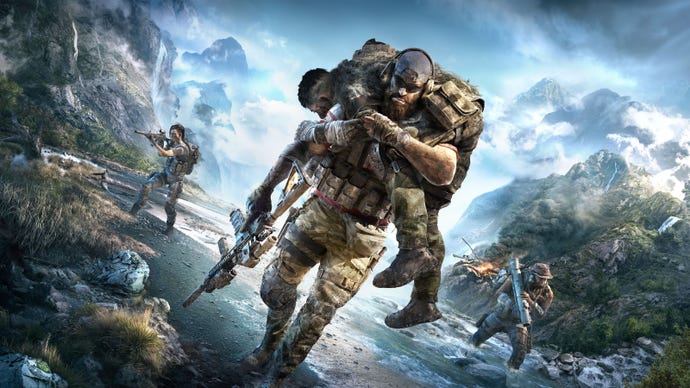How can Ghost Recon get back to its original vision?
Over the past decade, Sam Fisher has starred in as many Ghost Recon games as Splinter Cells. He popped up in Wildlands’ Bolivia to chase down a rogue CIA agent, and appears this week on Auroa, the billionaire-owned island of Breakpoint. In fact, the trailer for Ghost Recon’s new episode is stuffed with Splinter Cell iconography: a stealth-crouched Fisher, three green eyes, and the cat-bothering squeal of his night vision goggles.
There’s nothing wrong with a cameo, but it’s starting to feel as if Ubisoft is trading off the cachet of a better-defined series. You’d be hard-pressed to boil down the key characteristics of modern Ghost Recon in the same way: helicopters? Military bants? Base jumping? Ghost Recon: Breakpoint is the gaming equivalent of that time, as a child, you mixed together all of the paints and discovered the disappointing result was brown.
Oddly enough, that’s pretty much the company line. Late last year, Ubisoft CEO Yves Guillemot told investors that the new Ghost Recon “has been strongly rejected by a significant portion of the community”.
“Breakpoint did not come in with enough differentiation factors, which prevented the game’s intrinsic qualities from standing out,” said Guillemot. Players are now struggling to work out why they’d play Ghost Recon over, say, The Division 2 - which offers the same open-world shooting and high-tech gear hoovering at a higher standard.
If Ubisoft is serious about rediscovering an identity for Ghost Recon, it ought to return to the source: the very first game in the series, set in the future year 2008. Back then, all of the Tom Clancy games were developed by Red Storm, the studio founded by the author himself (history fans will be interested to know that, as Ghost Recon was being readied for release in September 2001, Clancy was live on CNN recommending that the CIA upgrade its human intelligence capabilities).
This was only the second shooter to bear the Clancy name, and distanced itself from Rainbow Six’s cramped, room-to-room exchanges with a wide-open play area. That’s not to say that Ghost Recon has always been an open-world game - the genre didn’t exist then in the way we understand it now - but its levels took place across large stretches of Georgian countryside. The polygonal topography looks ancient, of course, yet there’s an evocative starkness to these Eastern European slopes, especially under a white winter sun that doesn’t seem to have aged at all.
That world only seems broader thanks to the missing guns and reload animations. Ghost Recon’s HUD is totally clear of the peripheral ornaments first-person shooters tend to stack along the bottom of the screen. That’s not because it’s an old game: Half-Life pre-dates it, not to mention Doom. Instead that clean view is a tactical necessity. You’ll be grateful for the screen real estate once you’re straining to pick out camouflaged rebels along the treeline.
Like its environment, Ghost Recon is cold and cruel. There’s no damage indicator, because if you’ve already taken damage, you’re dead. Victory is decided entirely by which combatant gets the drop on the other. You’ll spend long, tense missions crawling on your belly, sending your squads forwards as spotters. In contrast to the drone-filled adventures to come, the original game doesn’t fill your pockets with gadgets designed to detect the temperature change caused by a bead of sweat on a terrorist’s forehead a mile away. Thankfully, the AI knows to freeze the moment it spots movement.
Today, the title Ghost suggests a predator-like dominance over the battlefield, a life lived between melee takedowns. In 2001, the shaky invisibility field provided by tree cover and sheer distance was the only armour you had.
It’s worth noting that ‘you’ is an abstract concept in Ghost Recon. You don’t play as Nomad, nor any other specific soldier. Instead, as was the custom in tactical shooters of the time, you can jump freely between the bodies of every unit under your command. You don’t lead the squad - you are the squad, as an entity.
It’s a system that essentially gives you six lives to lose, like two-thirds of a cat. And you’ll lose them all, one by one, as you work out how to navigate missions that ask you not just to cross a map but to save a downed pilot and blow up his plane, or halt a tank convoy headed for a NATO outpost. Each soldier is a specialist, so you learn to field your sniper alone and keep your demo-man out of harm’s way until it’s time to blow something up.
Despite the difficulty, it’s all surprisingly simple. A couple of the number keys on your keyboard essentially set a mood for your squaddies: crouched and careful, for instance, or last-roll-of-Andrex-in-Asda aggressive. And when you want to plant them somewhere specific, you click a position on your command map, and drag to set a vision cone. Somehow, despite Breakpoint’s action focus and absent squad, its parent is far less fiddly.
Ghost Recon doesn’t need to become a retro simulator for a subset of fans who read military biographies. Reinventions and updates are a necessary part of any long-running series, and 2006’s Advanced Warfighter was a stellar entry that mixed thoughtful pacing with third-person action. But there’s a clear identity here for Ubisoft to draw on: right from the beginning, Ghost Recon was a game that left you exposed and overwhelmed, yet tactically empowered. Let’s hope we can say the same for its next reboot.
Ghost Recon Breakpoint is free to play all this weekend. Fill your boots.





